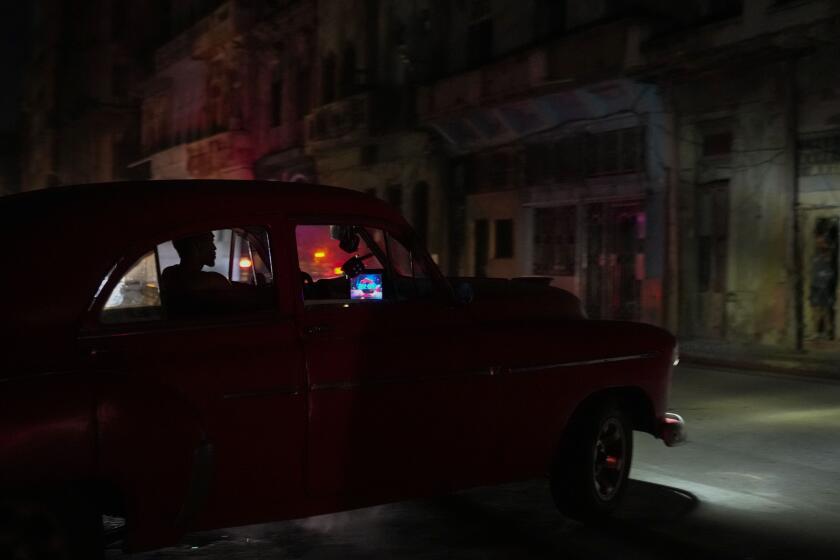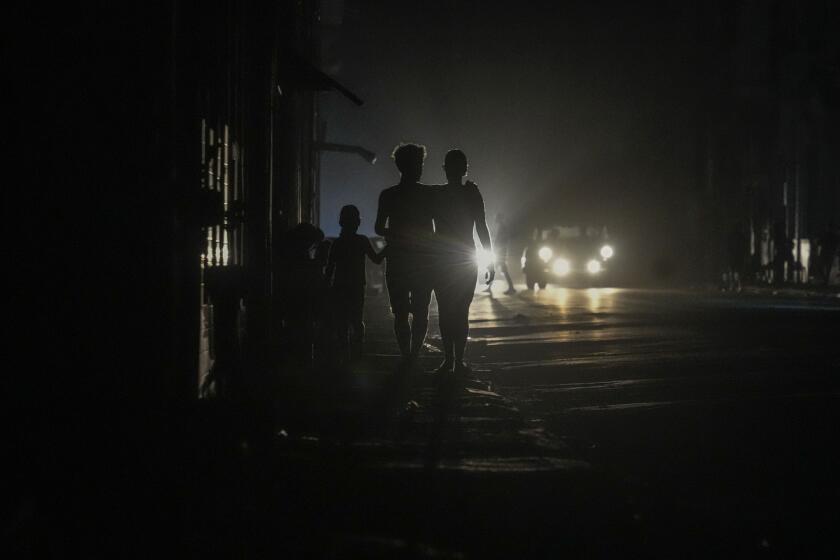Cuba left reeling after Category 3 hurricane ravages island and knocks out power grid

- Share via
HAVANA — Cuba was left reeling Thursday after a fierce Category 3 hurricane ripped across the island, knocking out the country’s power grid, downing trees and damaging infrastructure. No fatalities were immediately reported.
Hurricane Rafael crossed a western portion of Cuba on Wednesday evening about 45 miles west of Havana, where José Ignacio Dimas returned home from his night shift as a security guard to find his apartment building in the historic center of the city had collapsed.
“The entire front wall of the building fell,” he said in a tight voice as he scanned the damage early Thursday. Like many buildings in the capital, it was aging and lacked maintenance.
Some 50,000 people took shelter in Havana, with thousands more doing the same in regions south and just west of the capital since they lived in flood zones or in flimsy homes. The main road from Havana to the southern coastal city of Batabanó was strewn with dozens of utility poles and wires.
Cuba’s electrical grid went down after one of the island’s major power plants failed, leaving millions without power.
Lázaro Guerra, electricity director for the Ministry of Energy and Mines, said power had been partially restored in the island’s western region and that generation units were powering back up. But he warned that restoring power would be slow-going as crews took safety precautions.
As Rafael plowed across Cuba on Wednesday evening it slowed to a Category 2 hurricane and chugged into the Gulf of Mexico before heading toward Mexico, according to the National Hurricane Center in Miami.
Late Thursday morning, the hurricane was about 200 miles west-northwest of Havana. It had maximum sustained winds of 100 mph and was moving west-northwest at 9 mph.
Earlier in the week, Rafael brushed past Jamaica and battered the Cayman Islands, downing trees and power lines and unleashing heavy flooding in some areas.
Havana was partially illuminated Monday night after the large-scale blackout generated protests and a stern government warning against any unrest.
Authorities in Jamaica are searching for a couple last seen inside a car that was swept away by floodwaters, police told Radio Jamaica News.
Thousands of customers in Jamaica and Little Cayman remained without power as crews worked to restore electricity after the storm.
Rafael was expected to keep weakening as it spins over open waters and heads toward northern Mexico, although the hurricane center warned there was “above average uncertainty” in the storm’s future track.
Meanwhile, many Cubans were left picking up the pieces from Wednesday night, after a rocky few weeks in the Caribbean nation. In October, the island was hit by a one-two punch. First, it was hit by island-wide blackouts stretching on for days, a product of the island’s energy crisis. Shortly afterward, it was slapped by a powerful hurricane that struck the eastern part of the island and killed at least six people.
The disasters have stoked discontent already simmering in Cuba amid an ongoing economic crisis, which has pushed many to migrate from Cuba.
Thousands of people in the west of the island were evacuated as a prevention measure before Rafael was expected to slam into Cuba on Wednesday.
Classes and public transport were suspended on parts of the island and authorities canceled flights in and out of Havana and Varadero. Thousands of people in the west of the island had been evacuated as a preventative measure.
Rafael is the 17th named storm of the season.
The National Oceanic and Atmospheric Administration predicted the 2024 hurricane season was likely to be well above average, with 17 to 25 named storms. The forecast called for as many as 13 hurricanes and four major hurricanes.
An average Atlantic hurricane season produces 14 named storms, seven of them hurricanes and three major hurricanes.
Rodríguez writes for the Associated Press.
More to Read
Sign up for Essential California
The most important California stories and recommendations in your inbox every morning.
You may occasionally receive promotional content from the Los Angeles Times.












